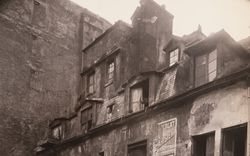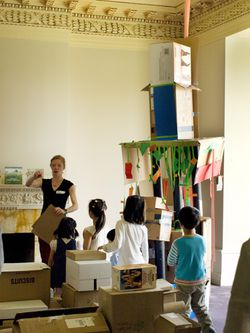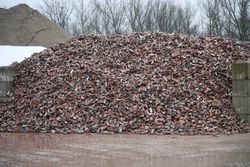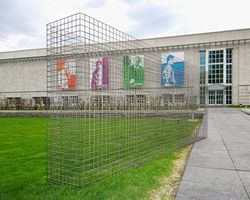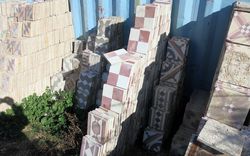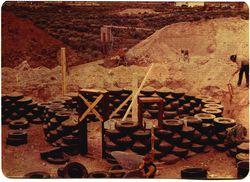Project
Energy FREE TREE (2017)
AP207.S1.2017.PR03
Description:
The project series documents the installation "Energy FREE TREE" designed by Pettena and presented at Museion in Bozen, in 2017. The installation consists of a tower measuring eight meters high by four meters wide. The tower is built with parts, including doors, fenders, exhaust pipes, and lights, and is meant to represent a Christmas tree standing next to the museum entrance during Christmas. "The work was, in fact, meant to trigger ‘mental shortcircuits [sic]’ in order to obtain a reaction so as to introduce the subject of environmental awareness and the need of using recycled materials to reduce damages to the environment as much as possible." [1] The project series contains a video, photographs of the installation, and two drawings. Source: [1] Gianni Pettena website, https://www.giannipettena.it/italiano/opere-1/inst-energy-free-tree-2017-1/ (last accessed 28 January 2020)
2017-2018
Energy FREE TREE (2017)
Actions:
AP207.S1.2017.PR03
Description:
The project series documents the installation "Energy FREE TREE" designed by Pettena and presented at Museion in Bozen, in 2017. The installation consists of a tower measuring eight meters high by four meters wide. The tower is built with parts, including doors, fenders, exhaust pipes, and lights, and is meant to represent a Christmas tree standing next to the museum entrance during Christmas. "The work was, in fact, meant to trigger ‘mental shortcircuits [sic]’ in order to obtain a reaction so as to introduce the subject of environmental awareness and the need of using recycled materials to reduce damages to the environment as much as possible." [1] The project series contains a video, photographs of the installation, and two drawings. Source: [1] Gianni Pettena website, https://www.giannipettena.it/italiano/opere-1/inst-energy-free-tree-2017-1/ (last accessed 28 January 2020)
Project
2017-2018
articles
Detritus, Waste, Salvage
Into the material world
18th century, 19th century, rubbish, trash, salvage, recycling, André Guillerme, construction, demolition, Paris, round table
18 January 2017
Into the material world
Families explore the creative potential of a recycled material by building houses and other imagined structures in cardboard. Inspired by the exhibition 1973: Sorry, Out of Gas (2007), Cardboard Houses introduces innovative ways of building that have a reduced environmental impact.
27 April 2008
Cardboard Houses: Exploration of Do-It-Yourself
Actions:
Description:
Families explore the creative potential of a recycled material by building houses and other imagined structures in cardboard. Inspired by the exhibition 1973: Sorry, Out of Gas (2007), Cardboard Houses introduces innovative ways of building that have a reduced environmental impact.
Learning from... Brussels
Rotor members Michael Ghyoot and Maarten Gielen investigate the processes and practices of material management in Brussels and its suburbs. The concept of waste played a key role in their research and was informed by hundreds of visits to businesses, work sites, and recycling plants. The examination of discarded, unfinished products or those considered of inferior quality(...)
Paul Desmarais Theatre
19 April 2012 , 7pm
Learning from... Brussels
Actions:
Description:
Rotor members Michael Ghyoot and Maarten Gielen investigate the processes and practices of material management in Brussels and its suburbs. The concept of waste played a key role in their research and was informed by hundreds of visits to businesses, work sites, and recycling plants. The examination of discarded, unfinished products or those considered of inferior quality(...)
Paul Desmarais Theatre
Absent Wall: Recalling Gordon Matta-Clark’s Garbage Wall (1970), an installation in the CCA’s Baile Park, is a symbolic structure that evokes Matta-Clark’s interest in recycling, leftover spaces, and alternatives to architectural design. On the occasion of the first Earth Day, Gordon Matta-Clark orchestrated an event at Manhattan’s St. Mark’s Church that took place from(...)
Baile Park
6 May 2004 to 6 September 2004
Absent Wall: Recalling Gordon Matta-Clark’s Garbage Wall (1970)
Actions:
Description:
Absent Wall: Recalling Gordon Matta-Clark’s Garbage Wall (1970), an installation in the CCA’s Baile Park, is a symbolic structure that evokes Matta-Clark’s interest in recycling, leftover spaces, and alternatives to architectural design. On the occasion of the first Earth Day, Gordon Matta-Clark orchestrated an event at Manhattan’s St. Mark’s Church that took place from(...)
Baile Park
Project
AP154.S1.1979.PR01
Description:
Project series AP154.S1.1979.PR01, George & Annette Murphy Center at Asphalt Green, New York, N.Y. (1979), documents an executed project to recycle a municipal asphalt plant into a youth sports and arts center. Clients for the project were the New York City Department of General Services and the Neighborhood Committee for the Asphalt Green, chaired by Dr. George Murphy. The asphalt plant was a parabolic structure built in the 1940s by the firm Kahn and Jacobs. Pasanella + Klein worked on the adaptive reuse project with HOK, successors to Kahn and Jacobs. The transformed interior includes two gymnasia of different sizes, a running track, art and photography studios, offices, lockers, showers and a theatre. The design includes an on-site total energy plant. The project series consists of presentation drawings. References: Kerr, Laurie. "Back to the future", Oculus, v. 64, no. 7/8 (March/April 2002), p. 7-8. Dixon, John Morris. "25-year watch", Oculus, v. 71, issue 1 (spring 2009) Doubilet, Susan. "Arch support", Progressive architecture, v. 66, no. 11 (Nov. 1985), p. 101 Architektur + Wettbewerbe, 127 (Sept. 1986), p. 16-17
between 1979 and 1984?
George & Annette Murphy Center at Asphalt Green, New York, N.Y. (1979)
Actions:
AP154.S1.1979.PR01
Description:
Project series AP154.S1.1979.PR01, George & Annette Murphy Center at Asphalt Green, New York, N.Y. (1979), documents an executed project to recycle a municipal asphalt plant into a youth sports and arts center. Clients for the project were the New York City Department of General Services and the Neighborhood Committee for the Asphalt Green, chaired by Dr. George Murphy. The asphalt plant was a parabolic structure built in the 1940s by the firm Kahn and Jacobs. Pasanella + Klein worked on the adaptive reuse project with HOK, successors to Kahn and Jacobs. The transformed interior includes two gymnasia of different sizes, a running track, art and photography studios, offices, lockers, showers and a theatre. The design includes an on-site total energy plant. The project series consists of presentation drawings. References: Kerr, Laurie. "Back to the future", Oculus, v. 64, no. 7/8 (March/April 2002), p. 7-8. Dixon, John Morris. "25-year watch", Oculus, v. 71, issue 1 (spring 2009) Doubilet, Susan. "Arch support", Progressive architecture, v. 66, no. 11 (Nov. 1985), p. 101 Architektur + Wettbewerbe, 127 (Sept. 1986), p. 16-17
Project
between 1979 and 1984?
Project
AP075.S1.1994.PR01
Description:
Project series documents Cornelia Hahn Oberlander's project of a roof garden for the New Canadian Embassy at Leipziger Platz in Berlin, Germany. Oberlander worked on this project in from 1999-2005 with architectural firm Kuwabara, Payne, McKenna, Blumberg Architects. Oberlander's work for the project included a terrace at the Ambassador's Level (6th floor) with mounded evergreen white flowering groundcover azaleas, cascading roses hanging along the Leipzigerstrasse facade, and a green roof on top of the building. The concept of the landscaping of the green roof was to represente Canada's land of the north in an abstract form, simulating the river system of the MacKenzie River in the Northwest Territories, linking Alberta to the Arctic Ocean. She used black-glass panels to represente the water. The drainage for the green roof was also connected the drainage infrastructure of the building to recycle the water collected from the roof. The project series includes sketches and design development drawings for the green roof landscaping, planting details and irrigation details, presentation drawings from KPMB and drawings of the building used as reference. The project is also documented through research material, concept notes by Oberlander, correspondence, including with architects, consultants, contractors and clients, proposal, specifications, and press clippings about the project. The project series also includes sample of glass tiles used for the landscaping.
1994-2005
New Canadian Embassy in Berlin, Germany (1994-2005)
Actions:
AP075.S1.1994.PR01
Description:
Project series documents Cornelia Hahn Oberlander's project of a roof garden for the New Canadian Embassy at Leipziger Platz in Berlin, Germany. Oberlander worked on this project in from 1999-2005 with architectural firm Kuwabara, Payne, McKenna, Blumberg Architects. Oberlander's work for the project included a terrace at the Ambassador's Level (6th floor) with mounded evergreen white flowering groundcover azaleas, cascading roses hanging along the Leipzigerstrasse facade, and a green roof on top of the building. The concept of the landscaping of the green roof was to represente Canada's land of the north in an abstract form, simulating the river system of the MacKenzie River in the Northwest Territories, linking Alberta to the Arctic Ocean. She used black-glass panels to represente the water. The drainage for the green roof was also connected the drainage infrastructure of the building to recycle the water collected from the roof. The project series includes sketches and design development drawings for the green roof landscaping, planting details and irrigation details, presentation drawings from KPMB and drawings of the building used as reference. The project is also documented through research material, concept notes by Oberlander, correspondence, including with architects, consultants, contractors and clients, proposal, specifications, and press clippings about the project. The project series also includes sample of glass tiles used for the landscaping.
Project
1994-2005
articles
Into the material world
Project
Hair Tent
AP144.S2.D76
Description:
File documents the Hair Tent, a temporary theatre structure which was to house performances of the musical 'Hair', in Holland, for David Convyers Productions Ltd. Cedric Price was hired to convert a tent into a theatre venue. The tent structure was designed for an audience of 1,200 and was to be used for a six-month period. Due to cost and time constraints, the materials were recycled: the seating came from a demolished cinema; the steel structure from a field near Hartlepool; and the mobile heating was provided by the Dutch Military (Cedric Price-Works II). Design development drawings show numerous plans and sections of the tent structure and structural components; a plan and section show the seating arrangements; a section through the tent shows various internal stackable structures; and an axonometric view of the site shows the main tent, a tin hut entrance bar, and military mobile heaters. Reprographic copies of construction drawings of a Cinerama and circus structure with details of trussing configurations, mast layout and anchor plans were possibly for reference purposes. Some material in this file was published in "Cedric Price Supplement", 'Architectural Design', vol. 40, (October 1970), 516, and Price, Cedric, 'Cedric Price-Works II' (London: Architectural Press, 1984), 72, 76. Material in this file was produced between 1963 and 1971. Reference drawings included with the design development drawings are inscribed with the name L. Stromeyer, engineer, or Leonard Allen, architect. Tom Parkinson and Victor Spinetti are involved in the project. File contains design development drawings, photographic materials, and textual records.
1963-1971
Hair Tent
Actions:
AP144.S2.D76
Description:
File documents the Hair Tent, a temporary theatre structure which was to house performances of the musical 'Hair', in Holland, for David Convyers Productions Ltd. Cedric Price was hired to convert a tent into a theatre venue. The tent structure was designed for an audience of 1,200 and was to be used for a six-month period. Due to cost and time constraints, the materials were recycled: the seating came from a demolished cinema; the steel structure from a field near Hartlepool; and the mobile heating was provided by the Dutch Military (Cedric Price-Works II). Design development drawings show numerous plans and sections of the tent structure and structural components; a plan and section show the seating arrangements; a section through the tent shows various internal stackable structures; and an axonometric view of the site shows the main tent, a tin hut entrance bar, and military mobile heaters. Reprographic copies of construction drawings of a Cinerama and circus structure with details of trussing configurations, mast layout and anchor plans were possibly for reference purposes. Some material in this file was published in "Cedric Price Supplement", 'Architectural Design', vol. 40, (October 1970), 516, and Price, Cedric, 'Cedric Price-Works II' (London: Architectural Press, 1984), 72, 76. Material in this file was produced between 1963 and 1971. Reference drawings included with the design development drawings are inscribed with the name L. Stromeyer, engineer, or Leonard Allen, architect. Tom Parkinson and Victor Spinetti are involved in the project. File contains design development drawings, photographic materials, and textual records.
File 76
1963-1971
In the Yesterday Today lecture series, American architect Michael Reynolds discusses Earthship houses, which use recycled materials and sustainable energy technologies to create autonomous dwellings. The structure and systems of Earthships are integrated so that all materials have a secondary use, from the greywater system in bathrooms and kitchens to planter boxes in(...)
Paul-Desmarais Theatre
15 November 2007
Michael Reynolds: The Earthship Sustainable Housing Concept
Actions:
Description:
In the Yesterday Today lecture series, American architect Michael Reynolds discusses Earthship houses, which use recycled materials and sustainable energy technologies to create autonomous dwellings. The structure and systems of Earthships are integrated so that all materials have a secondary use, from the greywater system in bathrooms and kitchens to planter boxes in(...)
Paul-Desmarais Theatre
